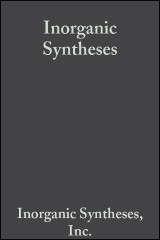Details

Inorganic Syntheses, Volume 15
Inorganic Syntheses, Band 15 1. Aufl.
|
110,99 € |
|
| Verlag: | Wiley |
| Format: | |
| Veröffentl.: | 22.09.2009 |
| ISBN/EAN: | 9780470132814 |
| Sprache: | englisch |
| Anzahl Seiten: | 282 |
DRM-geschütztes eBook, Sie benötigen z.B. Adobe Digital Editions und eine Adobe ID zum Lesen.
Beschreibungen
<p>The volumes in this continuing series provide a compilation of current techniques and ideas in inorganic synthetic chemistry. Includes inorganic polymer syntheses and preparation of important inorganic solids, syntheses used in the development of pharmacologically active inorganic compounds, small-molecule coordination complexes, and related compounds. Also contains valuable information on transition organometallic compounds including species with metal-metal cluster molecules. All syntheses presented here have been tested.</p>
Preface. <p>Notice to Contributors.</p> <p><b>Chapter One Metal Complexes of Olefins.</b></p> <p>1 Bis(1.3.5 7-cyclooctatetraene)iron(0).</p> <p>2 Bis(1,4-cyclooctadiene)nickel(0).</p> <p>3 Ethylenebis(tri-<i>o</i>-tolyl phosphite)nickel(0) and Tris(tri-<i>o</i>-tolyl phosphite)nickel(0).</p> <p>4 Di-<i>µ</i>-chlorotetrakis(ethylene)dirhodium(I), 2,4-Pentanedionatobis(ethylene)rhodium(I), and Di-<i>µ</i>-chlorotetracarbonyldirhodium(I).</p> <p>5 Cyclooctene and 1,5-Cyclooctadiene Complexes of Iridium(I).</p> <p><b>Chapter Two Metal Complexes of Dinitrogen and of Hydrogen.</b></p> <p>6 <i>trans</i>(Dinitrogen)bis[ethylenebis(diethylphosphine)]hydridoiron(II).</p> <p>7 <i>trans</i>-Bis(dinitrogen)bis[ethylenebis(diphenylphosphine)]molybdenum(0).</p> <p>8 (<i>µ</i>-Dinitrogen-N,N')bis[bis(tricyclohexylphosphine)nickel(0)].</p> <p>9 Dinitrogen and Hydrogen Complexes of Ruthenium.</p> <p>10 Pentahydridobis(trimethylphosphine)iridium(V).</p> <p>11 Hydride Complexes of Iron(II) and Ruthenium(II).</p> <p>12 Tetrahydridotetrakis(methyldiphenylphosphine)molybdenum(IV).</p> <p><b>Chapter Three Triphenylphosphine Complexes of Transition Metals.</b></p> <p>13 Complexes of Ruthenium, Osmium, Rhodium, and Iridium Containing Hydride, Carbonyl, or Nitrosyl Ligands.</p> <p>14 Fluoro Complexes of Rhodium(I) and Iridium(I).</p> <p>15 Covalent Perchlorato Complexes of Iridium and Rhodium.</p> <p>16 <i>trans</i>-Carbonyl(cyanotrihydridoborato)bis(triphenylphosphine)rhodium(I).</p> <p><b>Chapter Four Other Transition-Metal Compounds.</b></p> <p>17 <i>p</i>-Allyl Complexes of Palladium and Platinum.</p> <p>18 Dicarbonylchloro(p-toluidine)iridium(I).</p> <p>19 <i>µ</i>-Nitrido-bis(triphenylphosphorus)(1+)(“PPN”) Salts with Metal.</p> <p>20 Dicarbonyl-<i>h</i><sup><small>5</small></sup>-cyclopentadienylnitrosylmanganese(1+) Hexafluorophosphate (1–).</p> <p>21 Hexammineplatinum(IV) Chloride.</p> <p>22 Bis(1,1,1,5,5,5-hexafluoro-2,4-pentanedionato)nickel(II)and-cobalt(II).</p> <p>23 Ammonium Pentahalooxomolybdates(2–).</p> <p>24 13-Vanadomanganate(IV) and Nickelate(IV).</p> <p><b>Chapter Five Boron Compounds.</b></p> <p>25 Octahydrotriborate(1–)([B<sub><small>3</small></sub>H<sub><small>8</small></sub>]<sup><small>–</small></sup>) Salts.</p> <p>26 Pentaborane(9)([ B<sub><small>5</small></sub>H<sub><small>9</small></sub>]).</p> <p>27 Dimethylamine-Borane.</p> <p>28 Dimethylamine-Tribromoborane.</p> <p>29 Methyldiphenylphosphine-Borane and Dimethylphenylphosphine-Borane.</p> <p>30 Triphenylborane.</p> <p>31 Sodium Triethylhydroborate, Sodium Tetraethylborate, and Sodium Triethyl-1-propynylborate.</p> <p>32 Tetraalkyldiboranes and 9-Borabicyclo[3.3.1]nonane Dimer.</p> <p>33 Chlorodiethylborane and Chlorodiphenylborane.</p> <p><b>Chapter Six Germanium Hydride Derivatives.</b></p> <p>34 Bromogermane and Dibromogermane.</p> <p>35 Chlorogermane and Iodogermane.</p> <p>36 Fluorogermane and Digermylcarbodiimide.</p> <p>37 Iododigermane and Methyldigermane.</p> <p>38 Pentacarbonylgermylmanganese.</p> <p>39 Germylphosphine.</p> <p>40 Digermyl Sulfide(Digermthiane).</p> <p><b>Chapter Seven Phosphorous Compounds.</b></p> <p>41 Ethylenebis(dimethylphosphine)[1,2-bis(Dimethylphosphino)ethane], Tetramethyldiphosphane Disulfide, and Tetramethyldisphosphane.</p> <p>42 Dimethylphosphinothioic Chloride and Dimethylphosphinous Chloride.</p> <p>43 Phosphoric Trihalides.</p> <p>44 <i>µ</i>-Nitrido-bis[amidodiphenylphosphorus](1+) Chloride.</p> <p><b>Chapter Eight Main Group and Actinide Compounds.</b></p> <p>45 Trimethylgallium.</p> <p>46 Hexamethyldisilthiane and Hexamethylcyclotrisilthiane.</p> <p>47 Polyatomic Cations of Sulfur, Selenium, and Tellurium.</p> <p>48 Tetraethylammonium Trichlorogermanate(1–) and Tetrachlorostannate(1–).</p> <p>49 Weak and Unstable Anionic Bromo and Iodo Complexes.</p> <p>50 Hexahalouranate Salts.</p> <p>51 Pentachloro(trichloroacrylyl chloride)uranium(V).</p> <p>Index of Contributors.</p> <p>Subject Index.</p> <p>Formula Index.</p>
<strong>George W. Parshall</strong> is an organometallic chemist who made notable contributions to homogeneous catalysis. He was a senior scientist at E. I. du Pont de Nemours and Company for many years.
Diese Produkte könnten Sie auch interessieren:

Mass Spectrometry of Inorganic and Organometallic Compounds

von: William Henderson, J. Scott McIndoe

59,99 €

Neurodegenerative Diseases and Metal Ions, Volume 1

von: Astrid Sigel, Helmut Sigel, Roland K. O. Sigel

228,99 €














